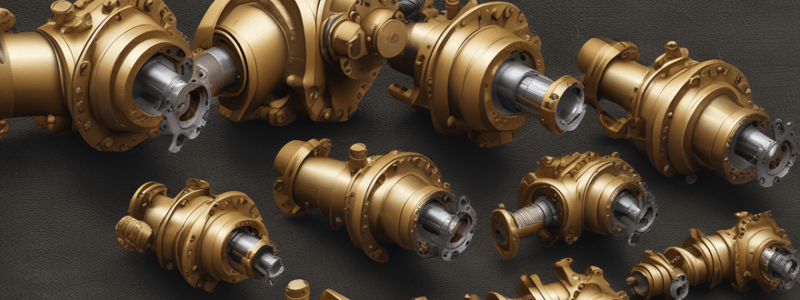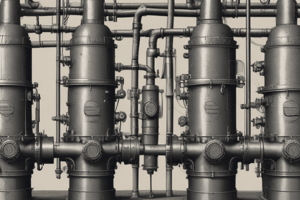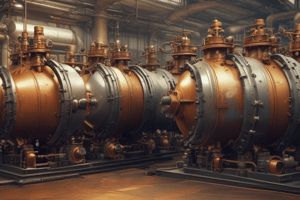Podcast
Questions and Answers
What is the primary function of pressure relief valves?
What is the primary function of pressure relief valves?
- To monitor temperature
- To relieve pressure from pressurized equipment (correct)
- To regulate fluid flow
- To compress fluids
According to ASME PTC-25, how many types of pressure relief devices are defined?
According to ASME PTC-25, how many types of pressure relief devices are defined?
- 15
- 7
- 5
- 11 (correct)
What is the main difference between a Relief Valve and a Safety Relief Valve?
What is the main difference between a Relief Valve and a Safety Relief Valve?
- Opening characteristics (correct)
- Type of fluid used
- Material used in construction
- Operating pressure range
Which type of pressure relief valve is normally used for compressible fluids?
Which type of pressure relief valve is normally used for compressible fluids?
What is the purpose of ASME BPVC I, Part PG-73.1.4?
What is the purpose of ASME BPVC I, Part PG-73.1.4?
What is the main difference between a Safety Valve and a Safety Relief Valve?
What is the main difference between a Safety Valve and a Safety Relief Valve?
Why are the terms 'safety valve', 'relief valve', and 'safety relief valve' often used interchangeably?
Why are the terms 'safety valve', 'relief valve', and 'safety relief valve' often used interchangeably?
What is the name of the standard that defines pressure relief valves?
What is the name of the standard that defines pressure relief valves?
What is the minimum number of pressure relief valves required for a boiler with more than 500 ft2 of bare tube water-heating surface?
What is the minimum number of pressure relief valves required for a boiler with more than 500 ft2 of bare tube water-heating surface?
What is the maximum allowed pressure rise above the highest pressure at which any valve is set?
What is the maximum allowed pressure rise above the highest pressure at which any valve is set?
What should be considered when determining the set pressure and relieving capacity of a superheater PRV?
What should be considered when determining the set pressure and relieving capacity of a superheater PRV?
What is the primary characteristic of a safety valve?
What is the primary characteristic of a safety valve?
What is the typical material used for constructing safety valves for superheaters operating over 230°C?
What is the typical material used for constructing safety valves for superheaters operating over 230°C?
What holds a safety valve disc tightly against its seat?
What holds a safety valve disc tightly against its seat?
What is the purpose of the exposed spring in the safety valve shown in Figure 2?
What is the purpose of the exposed spring in the safety valve shown in Figure 2?
How is the set point pressure of a safety valve adjusted?
How is the set point pressure of a safety valve adjusted?
Why is the try lever used on a safety valve?
Why is the try lever used on a safety valve?
What is the purpose of the seal attached to the adjusting nut by an authorized inspector?
What is the purpose of the seal attached to the adjusting nut by an authorized inspector?
What must be furnished and installed on the valve when a PRV set pressure is changed?
What must be furnished and installed on the valve when a PRV set pressure is changed?
What is the purpose of loosening the jam nut on the adjusting nut before adjusting the pressure at which the safety valve opens?
What is the purpose of loosening the jam nut on the adjusting nut before adjusting the pressure at which the safety valve opens?
What is the recommended installation position for safety valves mounted on the drum, superheater, reheater inlet and outlet headers?
What is the recommended installation position for safety valves mounted on the drum, superheater, reheater inlet and outlet headers?
According to ASME BPVC I, Part PG-73.1.4, which definition of pressure relief devices applies?
According to ASME BPVC I, Part PG-73.1.4, which definition of pressure relief devices applies?
What is the name of the standard that defines 11 different types of pressure relief valves?
What is the name of the standard that defines 11 different types of pressure relief valves?
What is the characteristic of a Relief Valve, according to ASME PTC-25?
What is the characteristic of a Relief Valve, according to ASME PTC-25?
What is the minimum number of pressure relief valves required for a boiler with more than 500 ft2 of bare tube water-heating surface?
What is the minimum number of pressure relief valves required for a boiler with more than 500 ft2 of bare tube water-heating surface?
What is the purpose of a discharge pipe in a safety valve arrangement?
What is the purpose of a discharge pipe in a safety valve arrangement?
What is the maximum steam temperature that a cast-iron safety valve can handle, according to Figure 7?
What is the maximum steam temperature that a cast-iron safety valve can handle, according to Figure 7?
What is the term that refers to all forms of reclosing pressure relief devices?
What is the term that refers to all forms of reclosing pressure relief devices?
What is the maximum allowed rise in pressure above the highest pressure at which any valve is set?
What is the maximum allowed rise in pressure above the highest pressure at which any valve is set?
What is the purpose of considering the pressure drop upstream of each pressure relief valve?
What is the purpose of considering the pressure drop upstream of each pressure relief valve?
What is the characteristic of a safety valve that distinguishes it from other pressure relief valves?
What is the characteristic of a safety valve that distinguishes it from other pressure relief valves?
What material is prohibited for use in superheater pressure relief valves operating over 230°C?
What material is prohibited for use in superheater pressure relief valves operating over 230°C?
What is the purpose of the exposed spring in Figure 2?
What is the purpose of the exposed spring in Figure 2?
What is the function of the nut 'L' in Figure 3?
What is the function of the nut 'L' in Figure 3?
Why is the try lever used to manually lift the valve?
Why is the try lever used to manually lift the valve?
What is the purpose of the guides on the valve disc?
What is the purpose of the guides on the valve disc?
What happens if the safety valve is opened without pressure in the boiler?
What happens if the safety valve is opened without pressure in the boiler?
What is the purpose of the seal attached to the nut 'L'?
What is the purpose of the seal attached to the nut 'L'?
What is the purpose of the guides at the bottom and top of the valve disc?
What is the purpose of the guides at the bottom and top of the valve disc?
What is the function of the huddling chamber in the safety valve?
What is the function of the huddling chamber in the safety valve?
What happens when the boiler pressure drops to below the popping pressure?
What happens when the boiler pressure drops to below the popping pressure?
What is the minimum blowdown required by ASME BPVC I, Part PG-72.1?
What is the minimum blowdown required by ASME BPVC I, Part PG-72.1?
What is the purpose of the blowdown adjusting ring?
What is the purpose of the blowdown adjusting ring?
What happens when the blowdown adjusting ring blocks the huddling chamber escape ports?
What happens when the blowdown adjusting ring blocks the huddling chamber escape ports?
How is the blowdown adjusting ring secured in place?
How is the blowdown adjusting ring secured in place?
What is the maximum percentage change allowed for the PRV set pressure?
What is the maximum percentage change allowed for the PRV set pressure?
What is the purpose of the compression spring in the PRV?
What is the purpose of the compression spring in the PRV?
What is the definition of blowdown according to ASME PTC-25?
What is the definition of blowdown according to ASME PTC-25?
What is the purpose of screwing the adjusting nut upwards on a safety valve?
What is the purpose of screwing the adjusting nut upwards on a safety valve?
What is the maximum steam temperature that the cast-iron safety valve in Figure 7 can handle?
What is the maximum steam temperature that the cast-iron safety valve in Figure 7 can handle?
What does ASME BPVC I, Part PG-71 cover?
What does ASME BPVC I, Part PG-71 cover?
How should safety valves be mounted on the boiler, according to ASME BPVC I, Part PG-71?
How should safety valves be mounted on the boiler, according to ASME BPVC I, Part PG-71?
What should be done with the discharge pipe, if used, according to ASME BPVC I, Part PG-71?
What should be done with the discharge pipe, if used, according to ASME BPVC I, Part PG-71?
Which ASME BPVC section is similar to the discharge piping arrangement shown in Figure 8?
Which ASME BPVC section is similar to the discharge piping arrangement shown in Figure 8?
What is the purpose of the huddling chamber in a safety valve?
What is the purpose of the huddling chamber in a safety valve?
What happens when the valve begins to lift and steam rushes into the huddling chamber?
What happens when the valve begins to lift and steam rushes into the huddling chamber?
What determines the lifting force exerted on the disc by the boiler pressure?
What determines the lifting force exerted on the disc by the boiler pressure?
What is blowdown, according to ASME PTC-25?
What is blowdown, according to ASME PTC-25?
What is the minimum blowdown required by ASME BPVC I, Part PG-72.1?
What is the minimum blowdown required by ASME BPVC I, Part PG-72.1?
What is the purpose of the blowdown adjusting ring?
What is the purpose of the blowdown adjusting ring?
What happens when the blowdown adjusting ring blocks the huddling chamber escape ports?
What happens when the blowdown adjusting ring blocks the huddling chamber escape ports?
How can the PRV set pressure be changed?
How can the PRV set pressure be changed?
What must be done when the PRV set pressure is changed?
What must be done when the PRV set pressure is changed?
What must be loosened before adjusting the pressure at which the safety valve opens?
What must be loosened before adjusting the pressure at which the safety valve opens?
Study Notes
Pressure Relief Valves
- Automatically open to relieve pressure and reclose after normal conditions have been restored
- Exist in many different varieties, with 11 types defined by ASME PTC-25 Pressure Relief Devices
Types of Pressure Relief Valves
- Pressure Relief Valve: designed to actuate on inlet static pressure and reclose after normal conditions have been restored
- Temperature and Pressure (T&P) Relief Valve: may be actuated by pressure at the valve inlet or by temperature at the valve inlet
- Relief Valve: characterized by gradual opening, generally proportional to the increase in pressure, used for incompressible fluids
- Safety Relief Valve: characterized by rapid opening or gradual opening, proportional to the increase in pressure, used for compressible or incompressible fluids
- Safety Valve: characterized by rapid opening, normally used to relieve compressible fluids
Safety Valve Construction
- Made of cast iron, steel, alloy steel, or bronze
- Cast iron and bronze safety valves are used for lower pressures and lower temperatures
- ASME BPVC Section I, Part PG-73 prohibits the use of valves with bronze parts for superheaters operating over 230°C
- ASME BPVC Section I, Part PG-68 requires all superheater and reheater pressure relief valves to be constructed of steel or alloy steel
Safety Valve Operation
- Held shut with a spring that holds a valve disc tightly against a seat
- When steam pressure reaches the set point pressure (popping pressure), the disc rises slightly from the seat, and steam begins to escape
- The valve disc has a lip (skirt) that forms a small compartment called a huddling chamber, which increases the effective area of the disc
- The valve lifts suddenly and "pops" to its full opening, and remains open until the pressure drops to below the popping pressure
Blowdown
- Defined as the difference between actual popping pressure and actual reseating pressure, expressed as a percentage of set pressure or in pressure units
- ASME BPVC I, Part PG-72.1 states that pressure relief valves shall be designed and constructed to operate with a minimum blowdown of 2 psi (15 kPa) or 2% of the set pressure
Installation and Adjustment
-
Blowdown adjusting rings can be moved up or down to vary the size of the huddling chamber escape port opening
-
Once adjusted to a particular position, the rings can be locked into place with a set screw, and then sealed in position
-
The adjustment ring can completely block off, partially obstruct, or fully open the huddling chamber escape ports### Boiler Pressure and Safety Valve Reclosure
-
The boiler pressure must drop significantly for the valve to reclose.
-
When the huddling chamber escape ports are fully open, the steam under the lip can exit, creating a lower pressure under the lip, allowing the valve to reclose with less drop in boiler pressure.
Adjusting the Blowdown Ring
- The adjustment ring can be set to an intermediate position, partially obstructing the escape ports, allowing the valve to reclose at a pressure in-between.
- To change the position of the blowdown adjusting ring, remove the locking screw and turn the adjusting ring in the desired direction with a screwdriver.
- After adjusting, lock the ring into place with the locking screw.
Preventing Unauthorized Tampering
- The locking screw is secured in place by a wire seal, installed by the jurisdictional Boiler Inspector, to prevent unauthorized tampering with the blowdown adjustment.
PRV Spring and Set Pressure
- The PRV spring is designed for a certain range of opening (or popping) pressure.
- The PRV set pressure can be increased or decreased by a maximum of five percent (5%) from the setting marked on the valve.
- Changing the set pressure requires a new valve data tag, and the valve must be resealed.
Adjusting the PRV Set Pressure
- Before adjusting the pressure, loosen the jam nut on the adjusting nut.
- To increase the popping pressure, screw the adjusting nut down to further compress the spring.
- To decrease the blowoff pressure, screw the adjusting nut upwards to decrease the spring compression.
Safety Valve Design and Installation
- ASME BPVC I covers safety valve design, material selection, capacity, testing, adjustments, and sealing.
- ASME BPVC I, Part PG-71 covers the installation of PRVs.
- Safety valves must be installed in an upright position with the spindle vertical, connected to the boiler independently, and located as close as possible to the boiler without unnecessary intervening pipe or fitting.
Discharge Piping Arrangement
- The discharge pipe should be separately supported, leaving ample room for expansion so that no force is exerted on the valve.
- The arrangement is similar to that shown in ASME BPVC, Section VII.
Studying That Suits You
Use AI to generate personalized quizzes and flashcards to suit your learning preferences.
Description
Learn about pressure relief valves, their functions, and different types, including pressure relief valves and temperature and pressure relief valves.




